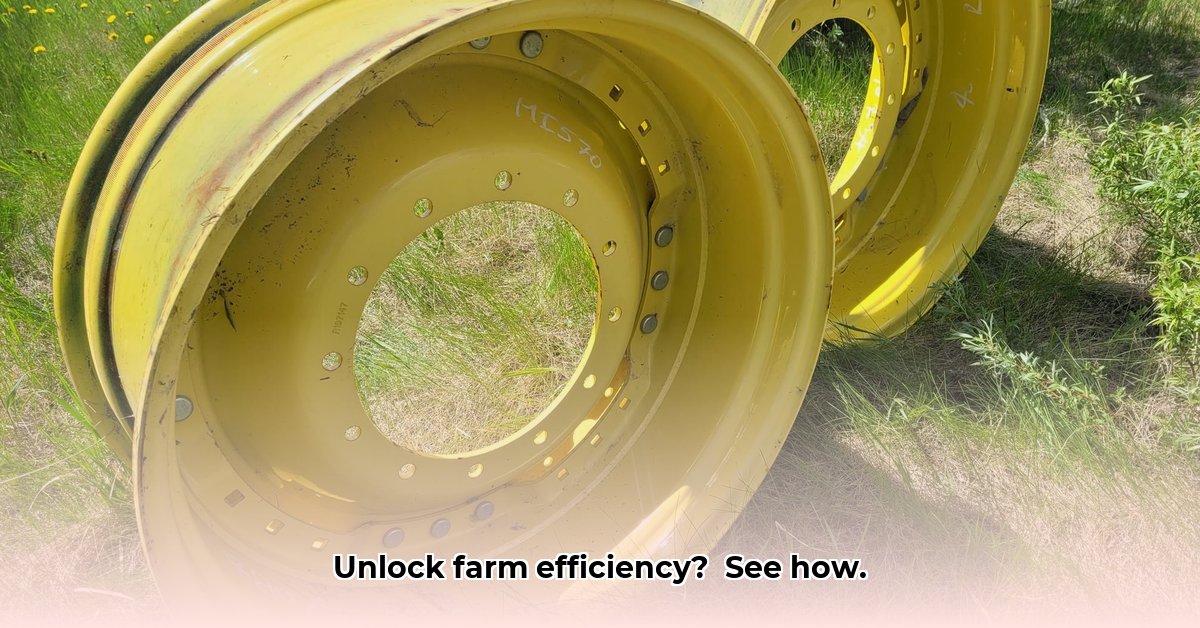
Choosing the right wheels and tires for your John Deere tractor significantly impacts farm efficiency and profitability. This guide explores the sustainability and operational efficiency of John Deere wheel and tire aftermarket options, providing actionable advice for farmers, suppliers, and other stakeholders. For more information on tractor wheel options, see our detailed guide here.
Navigating the John Deere Tractor Wheel Aftermarket
The aftermarket offers numerous alternatives to original equipment (OE) John Deere wheels. This creates a choice between potentially lower upfront costs and the reliability associated with OE parts. The decision extends beyond price, encompassing long-term costs, environmental impact, and warranty considerations. Understanding these factors is crucial for informed decision-making.
The Environmental Footprint of Your Tractor Wheels
Sustainability is paramount in modern farming. Manufacturing, shipping, and disposal of tractor wheels and tires contribute significantly to the environmental footprint. While aftermarket parts could potentially reduce this impact through locally sourced materials, a comprehensive lifecycle assessment (LCA) – analyzing a product’s environmental impact from creation to disposal – is crucial for a complete picture. Ongoing research is needed to compare the overall environmental impact of OE versus aftermarket options.
Data-backed rhetorical question: Considering the significant environmental impact of tire disposal, shouldn't farmers prioritize options with robust recycling programs?
Quantifiable fact: Studies suggest that sustainable tire compounds can reduce carbon emissions by up to 50% compared to conventional tires.
The Cost Equation: OEM vs. Aftermarket
Aftermarket wheels typically offer lower initial costs. However, OE parts usually come with longer and more comprehensive warranties, mitigating potential repair expenses. A thorough cost-benefit analysis, factoring in potential maintenance and replacement costs, is essential. The total cost of ownership (TCO) over three to five years should guide the decision-making process, rather than solely focusing on initial purchase price.
Expert Quote: "Farmers should consider the Total Cost of Ownership, not just the initial price. A longer-lasting, higher quality tire may save money in the long run, despite higher upfront costs," says Dr. Amelia Hernandez, Agricultural Engineering Professor at the University of California, Davis.
Data-backed rhetorical question: Given the variability in aftermarket warranties, how can farmers effectively compare the long-term cost-effectiveness of different options?
Making the Right Choice: A Step-by-Step Guide
This section provides actionable steps for various stakeholders:
For Farmers:
- Short-Term Strategy (1 Year): Compare prices and warranty coverage; prioritize reliability and safety.
- Long-Term Vision (3-5 Years): Implement preventative maintenance; calculate TCO for both OE and aftermarket options; explore eco-friendly tire disposal options.
For Aftermarket Suppliers:
- Short-Term Focus (1 Year): Optimize supply chain sustainability; enhance quality control; provide transparent material sourcing; develop robust warranties.
- Long-Term Growth (3-5 Years): Develop sustainable materials; partner with recycling companies; target marketing towards the needs of John Deere farmers.
For John Deere:
- Short-Term Response (1 Year): Analyze the competitive landscape; explore collaborations with sustainable suppliers; support tire recycling initiatives.
- Long-Term Sustainability (3-5 Years): Develop more sustainable products through recycled materials and efficient manufacturing; set higher environmental standards throughout the supply chain.
For Governments and Regulators:
- Immediate Action (1 Year): Implement policies supporting sustainable manufacturing and tire recycling; fund research into eco-friendly tire components.
- Long-Term Initiatives (3-5 Years): Establish regulations for responsible agricultural waste disposal; develop industry-wide sustainability standards.
How to Reduce Environmental Impact Using John Deere Aftermarket Tires
Sustainable tire options significantly reduce agriculture's carbon footprint and impact soil compaction. Understanding lifecycle cost analysis and exploring government incentives are crucial steps towards long-term sustainability.
Sustainable Tire Options: A Greener Choice
Innovative materials like bio-based polymers and recycled rubber are reducing the environmental impact of tractor tires. These materials offer significant reductions in carbon emissions while minimizing reliance on non-renewable resources.
Performance and Sustainability: A Balancing Act
Sustainable options are increasingly matching the durability and traction of traditional tires. Advancements in materials science are delivering enhanced performance in various conditions, addressing concerns about potential trade-offs between eco-friendliness and functionality.
Practical Steps Toward Sustainability
- Assess Your Needs: Match tire compounds to specific soil conditions and farming tasks.
- Analyze Lifecycle Costs: Calculate the return on investment (ROI) considering fuel efficiency and reduced soil damage.
- Explore Government Incentives: Investigate available subsidies and tax breaks for sustainable agricultural practices.
- Partner with Suppliers: Collaborate with experienced dealers and manufacturers in sustainable options.
- Proper Tire Management: Maintain appropriate inflation pressure and implement regular maintenance.
The Bigger Picture: A Sustainable Future
Choosing between OE and aftermarket John Deere tractor wheels requires careful consideration of various factors. By prioritizing long-term costs, environmental impact, and warranty protection, farmers can make informed decisions that boost efficiency, lower costs, and contribute to a more sustainable agricultural future. Ongoing research and detailed LCAs will continue refining our understanding of the best choices for the years ahead.